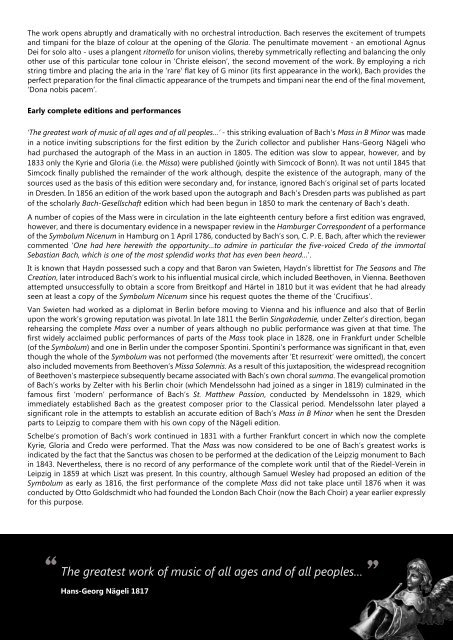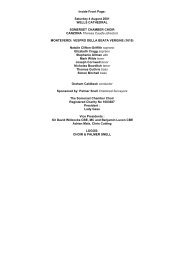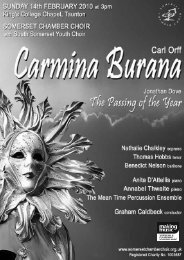Click here to view the concert programme - Somerset Chamber Choir
Click here to view the concert programme - Somerset Chamber Choir
Click here to view the concert programme - Somerset Chamber Choir
You also want an ePaper? Increase the reach of your titles
YUMPU automatically turns print PDFs into web optimized ePapers that Google loves.
The work opens abruptly and dramatically with no orchestral introduction. Bach reserves <strong>the</strong> excitement of trumpets<br />
and timpani for <strong>the</strong> blaze of colour at <strong>the</strong> opening of <strong>the</strong> Gloria. The penultimate movement - an emotional Agnus<br />
Dei for solo al<strong>to</strong> - uses a plangent ri<strong>to</strong>rnello for unison violins, t<strong>here</strong>by symmetrically reflecting and balancing <strong>the</strong> only<br />
o<strong>the</strong>r use of this particular <strong>to</strong>ne colour in ‘Christe eleison’, <strong>the</strong> second movement of <strong>the</strong> work. By employing a rich<br />
string timbre and placing <strong>the</strong> aria in <strong>the</strong> ‘rare’ flat key of G minor (its first appearance in <strong>the</strong> work), Bach provides <strong>the</strong><br />
perfect preparation for <strong>the</strong> final climactic appearance of <strong>the</strong> trumpets and timpani near <strong>the</strong> end of <strong>the</strong> final movement,<br />
‘Dona nobis pacem’.<br />
Early complete editions and performances<br />
‘The greatest work of music of all ages and of all peoples…’ - this striking evaluation of Bach’s Mass in B Minor was made<br />
in a notice inviting subscriptions for <strong>the</strong> first edition by <strong>the</strong> Zurich collec<strong>to</strong>r and publisher Hans-Georg Nägeli who<br />
had purchased <strong>the</strong> au<strong>to</strong>graph of <strong>the</strong> Mass in an auction in 1805. The edition was slow <strong>to</strong> appear, however, and by<br />
1833 only <strong>the</strong> Kyrie and Gloria (i.e. <strong>the</strong> Missa) were published (jointly with Simcock of Bonn). It was not until 1845 that<br />
Simcock finally published <strong>the</strong> remainder of <strong>the</strong> work although, despite <strong>the</strong> existence of <strong>the</strong> au<strong>to</strong>graph, many of <strong>the</strong><br />
sources used as <strong>the</strong> basis of this edition were secondary and, for instance, ignored Bach’s original set of parts located<br />
in Dresden. In 1856 an edition of <strong>the</strong> work based upon <strong>the</strong> au<strong>to</strong>graph and Bach’s Dresden parts was published as part<br />
of <strong>the</strong> scholarly Bach-Gesellschaft edition which had been begun in 1850 <strong>to</strong> mark <strong>the</strong> centenary of Bach’s death.<br />
A number of copies of <strong>the</strong> Mass were in circulation in <strong>the</strong> late eighteenth century before a first edition was engraved,<br />
however, and t<strong>here</strong> is documentary evidence in a newspaper re<strong>view</strong> in <strong>the</strong> Hamburger Correspondent of a performance<br />
of <strong>the</strong> Symbolum Nicenum in Hamburg on 1 April 1786, conducted by Bach’s son, C. P. E. Bach, after which <strong>the</strong> re<strong>view</strong>er<br />
commented ‘One had <strong>here</strong> <strong>here</strong>with <strong>the</strong> opportunity…<strong>to</strong> admire in particular <strong>the</strong> five-voiced Credo of <strong>the</strong> immortal<br />
Sebastian Bach, which is one of <strong>the</strong> most splendid works that has even been heard…’.<br />
It is known that Haydn possessed such a copy and that Baron van Swieten, Haydn’s librettist for The Seasons and The<br />
Creation, later introduced Bach’s work <strong>to</strong> his influential musical circle, which included Beethoven, in Vienna. Beethoven<br />
attempted unsuccessfully <strong>to</strong> obtain a score from Breitkopf and Härtel in 1810 but it was evident that he had already<br />
seen at least a copy of <strong>the</strong> Symbolum Nicenum since his request quotes <strong>the</strong> <strong>the</strong>me of <strong>the</strong> ‘Crucifixus’.<br />
Van Swieten had worked as a diplomat in Berlin before moving <strong>to</strong> Vienna and his influence and also that of Berlin<br />
upon <strong>the</strong> work’s growing reputation was pivotal. In late 1811 <strong>the</strong> Berlin Singakademie, under Zelter’s direction, began<br />
rehearsing <strong>the</strong> complete Mass over a number of years although no public performance was given at that time. The<br />
first widely acclaimed public performances of parts of <strong>the</strong> Mass <strong>to</strong>ok place in 1828, one in Frankfurt under Schelble<br />
(of <strong>the</strong> Symbolum) and one in Berlin under <strong>the</strong> composer Spontini. Spontini’s performance was significant in that, even<br />
though <strong>the</strong> whole of <strong>the</strong> Symbolum was not performed (<strong>the</strong> movements after ‘Et resurrexit’ were omitted), <strong>the</strong> <strong>concert</strong><br />
also included movements from Beethoven’s Missa Solemnis. As a result of this juxtaposition, <strong>the</strong> widespread recognition<br />
of Beethoven’s masterpiece subsequently became associated with Bach’s own choral summa. The evangelical promotion<br />
of Bach’s works by Zelter with his Berlin choir (which Mendelssohn had joined as a singer in 1819) culminated in <strong>the</strong><br />
famous first ‘modern’ performance of Bach’s St. Mat<strong>the</strong>w Passion, conducted by Mendelssohn in 1829, which<br />
immediately established Bach as <strong>the</strong> greatest composer prior <strong>to</strong> <strong>the</strong> Classical period. Mendelssohn later played a<br />
significant role in <strong>the</strong> attempts <strong>to</strong> establish an accurate edition of Bach’s Mass in B Minor when he sent <strong>the</strong> Dresden<br />
parts <strong>to</strong> Leipzig <strong>to</strong> compare <strong>the</strong>m with his own copy of <strong>the</strong> Nägeli edition.<br />
Schelbe’s promotion of Bach’s work continued in 1831 with a fur<strong>the</strong>r Frankfurt <strong>concert</strong> in which now <strong>the</strong> complete<br />
Kyrie, Gloria and Credo were performed. That <strong>the</strong> Mass was now considered <strong>to</strong> be one of Bach’s greatest works is<br />
indicated by <strong>the</strong> fact that <strong>the</strong> Sanctus was chosen <strong>to</strong> be performed at <strong>the</strong> dedication of <strong>the</strong> Leipzig monument <strong>to</strong> Bach<br />
in 1843. Never<strong>the</strong>less, t<strong>here</strong> is no record of any performance of <strong>the</strong> complete work until that of <strong>the</strong> Riedel-Verein in<br />
Leipzig in 1859 at which Liszt was present. In this country, although Samuel Wesley had proposed an edition of <strong>the</strong><br />
Symbolum as early as 1816, <strong>the</strong> first performance of <strong>the</strong> complete Mass did not take place until 1876 when it was<br />
conducted by Ot<strong>to</strong> Goldschmidt who had founded <strong>the</strong> London Bach <strong>Choir</strong> (now <strong>the</strong> Bach <strong>Choir</strong>) a year earlier expressly<br />
for this purpose.<br />
"<br />
The greatest work of music of all ages and of all peoples…<br />
Hans-Georg Nägeli 1817<br />
"












